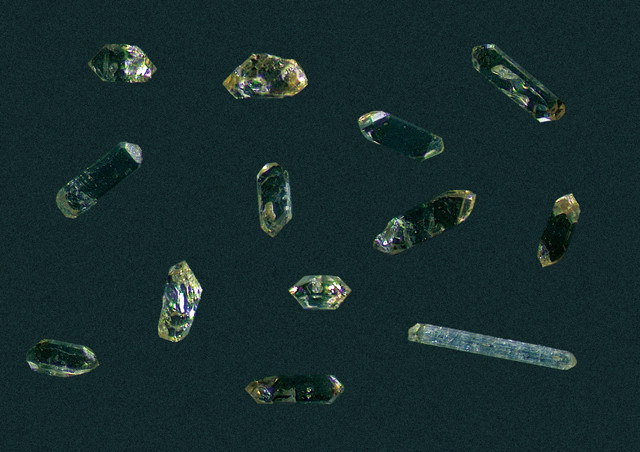
by Mary Caperton Morton Monday, May 15, 2017

Zircon crystals contain trace amounts of uranium and thorium, making them useful for radiometric dating. These highly magnified crystals are about the size of a grain of sand. Credit: Anders Lindskog.
During the Ordovician Period, roughly 470 million years ago, an asteroid the size of a small moon collided with another rocky object in the belt between Mars and Jupiter, shattering the asteroid into billions of pieces. Fragments from the epic collision still occasionally fall to Earth today, making up a large share of the meteorites recovered. But in the immediate wake of the Ordovician event, many pieces rained down on the planet, settling on the surface and in layers of rock forming at the time. In a new study, researchers studying some of these meteorite-rich layers have refined the timescale for the collision. The results bring into question a proposed link between the meteorite bombardment and an evolutionary uptick known as the Great Ordovician Biodiversification Event (GOBE).
Roughly 40 million years after the Cambrian Explosion, life underwent a new radiation during the GOBE in which the number of orders of marine life doubled and the number of families tripled. The causes of this rapid evolution are debated, but one theory credits the Ordovician meteorite bombardment, which may have destabilized the environment, for stimulating biodiversification.
In southern Sweden, a limestone quarry preserves layers of rock that formed on an ancient seafloor during the Ordovician. Over the past 25 years, more than 100 meteorites have been recovered from the quarry, all from this asteroid collision. “Finding meteorites in old rocks is usually like finding a needle in something much larger than a haystack,” says Anders Lindskog, a geologist at Lund University in Sweden and lead author of the new study, published in Nature Communications. “But this site is full of needles. It’s really quite extraordinary.”
Hidden within the meteorite-containing layers, Lindskog and his colleagues also retrieved zircon crystals, which are usually associated with volcanism. “These zircons are anomalous. They don’t belong in this environment,” he says. The rocks in this quarry were formed underwater and far from land. “Anything not seafloor-related that came here had to have come from the air,” he says. “In this case, we think the zircons were deposited by ashfall from a far-off explosive volcanic eruption.”
Based on the shape and condition of the crystals, particularly the sharp, unabraded edges, the researchers think the zircons were not reworked, but likely were erupted and rapidly deposited around the same time as the Ordovician meteor shower. Thus, they suggest, the zircons offer an indication of when the asteroid breakup event happened. Using uranium-lead isotope dating, the team dated nine zircons to 467.5 million years ago, the first radiometric dating of the meteorite-rich layers found in Sweden.
The team suggests this new date puts the timing off for the GOBE by almost 2 million years; an uptick in brachiopod and graptolite diversification often used as a marker for the onset of the GOBE started nearly 2 million years prior to the bombardment.
“We specifically add robust age constraints on the time interval in question, and put both the GOBE and the meteorite bombardment into a much better time perspective,” Lindskog says. “Our zircon data, together with meteorite, up-to-date biostratigraphic and lead-uranium data, provide a much refined timescale both in terms of absolute and relative time,” and imply that the asteroid breakup event did not initiate the biodiversification.
But Birger Schmitz, a geologist also at Lund University who was not part of the new study, takes issue with how the study uses the refinements in the Ordovician timescale to suggest that the asteroid breakup had nothing to do with the evolutionary burst that occurred around the same time. “A radiometric age for the zircons doesn’t provide any information about when the bombardment occurred,” he says. “It’s a leap to say it means there’s no connection to the Great Ordovician Biodiversification Event.”
The GOBE spanned much of the Ordovician and occurred in spurts, in different places at different times, making it difficult to determine the timing of its onset, Schmitz says.
© 2008-2021. All rights reserved. Any copying, redistribution or retransmission of any of the contents of this service without the expressed written permission of the American Geosciences Institute is expressly prohibited. Click here for all copyright requests.